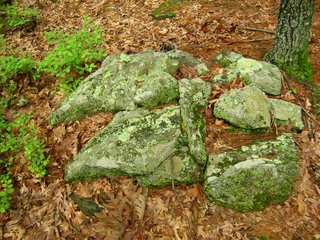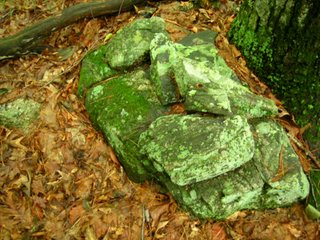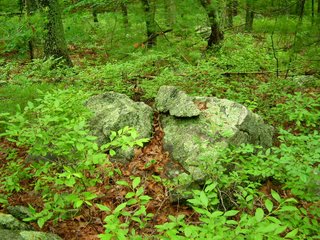 You can see the white oak trunk in the background. This is a tree about 3 feet in diameter, which I take to mean the tree (a slow growing white oak) is more than 100 years old. It seems likely it was there when the rest of the hill was clear of trees - perhaps when the rock piles were constructed. Now, as I look at these pictures with green color values close to the color of toxic waste, the color which the popsicle label calls "watermelon green" or "bubble gum", I cannot imaging why this Nikon camera gets good reviews. Luckily I did not buy it and can try some better models. Guys at work have lots of different ones to examine. Yet, surprisingly, every once in a while you get a decent picture:
You can see the white oak trunk in the background. This is a tree about 3 feet in diameter, which I take to mean the tree (a slow growing white oak) is more than 100 years old. It seems likely it was there when the rest of the hill was clear of trees - perhaps when the rock piles were constructed. Now, as I look at these pictures with green color values close to the color of toxic waste, the color which the popsicle label calls "watermelon green" or "bubble gum", I cannot imaging why this Nikon camera gets good reviews. Luckily I did not buy it and can try some better models. Guys at work have lots of different ones to examine. Yet, surprisingly, every once in a while you get a decent picture:  The resolution is fabulous and the colors are not bad. This pile seems to have a lot of symmetry along the horizontal axis which runs through the middle of the pile. Here is another: a view of a pile glimpsed through the leaves:
The resolution is fabulous and the colors are not bad. This pile seems to have a lot of symmetry along the horizontal axis which runs through the middle of the pile. Here is another: a view of a pile glimpsed through the leaves:  And then, just a bit higher on the hill and still close to the white oak, was this beautiful one - I love these piles on support. This one looks like it has sustained some damage.
And then, just a bit higher on the hill and still close to the white oak, was this beautiful one - I love these piles on support. This one looks like it has sustained some damage.  There were a number of other piles around but the pictures failed - they were too blurry. It turns out that at "low light levels" i.e. in the rain under the forest canopy, these digital cameras are having a hard time getting enough light to function properly. The autofocus fails and the colors go askew. I consider Larry Harrop's pictures to be the golden standard for rock pile photos but I think I saw one picture where the greens started to go and I am guessing this was another low light level situation. Apparently the solution is a camera with a long exposure time, a white point balance adjustment (combined with knowledge I do not have about how to use it) , and a very stable platform like a tripod. Lacking these I was only able to get a couple of other shots:
There were a number of other piles around but the pictures failed - they were too blurry. It turns out that at "low light levels" i.e. in the rain under the forest canopy, these digital cameras are having a hard time getting enough light to function properly. The autofocus fails and the colors go askew. I consider Larry Harrop's pictures to be the golden standard for rock pile photos but I think I saw one picture where the greens started to go and I am guessing this was another low light level situation. Apparently the solution is a camera with a long exposure time, a white point balance adjustment (combined with knowledge I do not have about how to use it) , and a very stable platform like a tripod. Lacking these I was only able to get a couple of other shots:
 There is a distinct sense of shape to these piles. Note again, this is uphill from a brookside site. Similar topography to what we saw on the Westford/Groton line along Rt 40.
There is a distinct sense of shape to these piles. Note again, this is uphill from a brookside site. Similar topography to what we saw on the Westford/Groton line along Rt 40.The final straw about this Nikon "Coolpix" dog of a camera is that after two days of minimal use, it ran out of batteries, without the advertised warning. This distracted me from paying much attention to what I was looking at. I tried to shoot some video clips (this was posted earlier)
This site runs back downhill until the sound of the brook - loud from all the rain - was audible and, with a continuum of rock piles, goes on down into the low wet area next to and between the brooks there, in areas where the sensitive eye sees that every single rock is part of a manipulated scene. These are shrines of one sort of another.
Sometime I will go back when I have learned how to take better pictures.
The "toxic waste" colors you're getting is a common problem when all the vegetation is very wet under an overcast sky. The first few pictures here http://larryharrop.com/main.php?g2_itemId=1630
ReplyDeletewere taken after a soaking over night rain.... Same problem, except mine are "watermelon green"
Under 'normal" conditions, your Nikon should perform well.
I am still looking at cameras. Your Lumix is perfect except there is no view finder on the less expensive/smaller model. The Canon "Powershot" looks good and I am going to try a friends Olympus. But I am going to un-borrow the Nikon. Cloudy conditions after rain should not be beyond a camera's capability.
ReplyDelete